Enterprise Networking, Security, and Automation ( Version 7.00) – Modules 6 – 8: WAN Concepts Exam
1. Which two statements accurately describe an advantage or a disadvantage when deploying NAT for IPv4 in a network? (Choose two.)
- NAT improves packet handling.
- NAT adds authentication capability to IPv4.
- NAT will impact negatively on switch performance.
- NAT causes routing tables to include more information.
- NAT provides a solution to slow down the IPv4 address depletion.
- NAT introduces problems for some applications that require end-to-end connectivity.
2. A network administrator wants to examine the active NAT translations on a border router. Which command would perform the task?
- Router# show ip nat translations
- Router# show ip nat statistics
- Router# clear ip nat translations
- Router# debug ip nat translations
3. What are two tasks to perform when configuring static NAT? (Choose two.)
- Configure a NAT pool.
- Create a mapping between the inside local and outside local addresses.
- Identify the participating interfaces as inside or outside interfaces.
- Define the inside global address on the server
- Define the outside global address.
4. What is a disadvantage of NAT?
- There is no end-to-end addressing.
- The router does not need to alter the checksum of the IPv4 packets.
- The internal hosts have to use a single public IPv4 address for external communication.
- The costs of readdressing hosts can be significant for a publicly addressed network.
5. Refer to the exhibit. From the perspective of R1, the NAT router, which address is the inside global address?
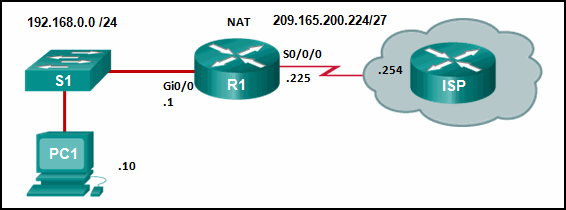
- 192.168.0.10
- 192.168.0.1
- 209.165.200.225
- 209.165.200.254
6. Refer to the exhibit. Given the commands as shown, how many hosts on the internal LAN off R1 can have simultaneous NAT translations on R1?
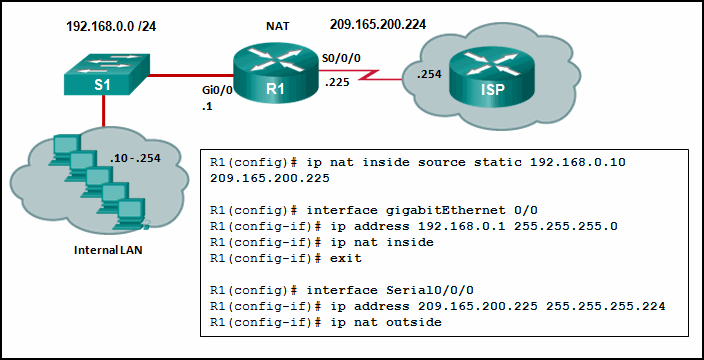
- 244
- 10
- 1
- 255
7. Refer to the exhibit. A network administrator has just configured address translation and is verifying the configuration. What three things can the administrator verify? (Choose three.)
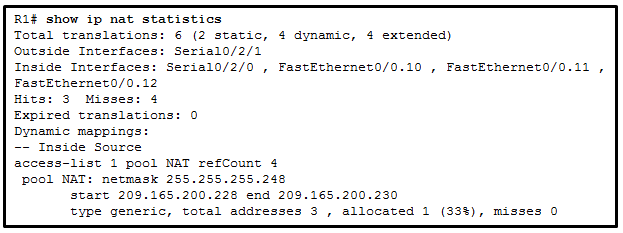
- A standard access list numbered 1 was used as part of the configuration process.
- Three addresses from the NAT pool are being used by hosts.
- Address translation is working.
- One port on the router is not participating in the address translation.
- The name of the NAT pool is refCount.
- Two types of NAT are enabled.
8. Refer to the exhibit. NAT is configured on RT1 and RT2. The PC is sending a request to the web server. What IPv4 address is the source IP address in the packet between RT2 and the web server?
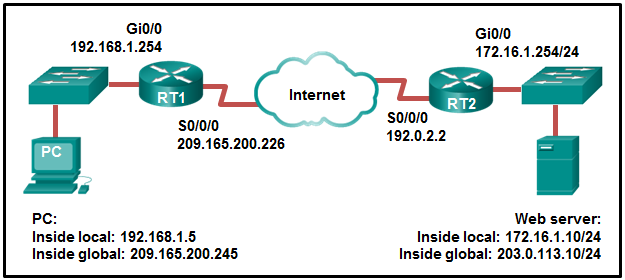
- 192.168.1.5
- 203.0.113.10
- 172.16.1.254
- 172.16.1.10
- 209.165.200.245
- 192.0.2.2
9. Refer to the exhibit. Based on the output that is shown, what type of NAT has been implemented?

- dynamic NAT with a pool of two public IP addresses
- PAT using an external interface
- static NAT with a NAT pool
- static NAT with one entry
10. Refer to the exhibit. From the perspective of users behind the NAT router, what type of NAT address is 209.165.201.1?
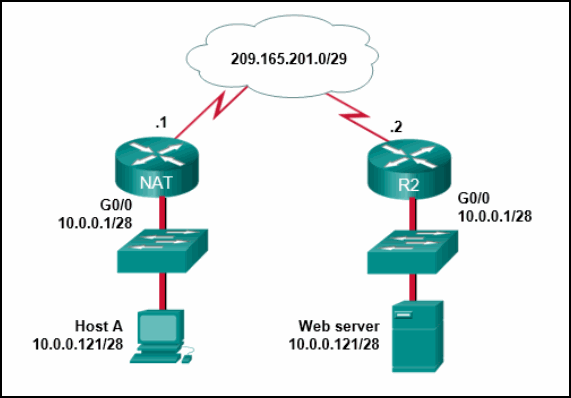
- inside global
- outside global
- outside local
- inside local
11. Refer to the exhibit. Static NAT is being configured to allow PC 1 access to the web server on the internal network. What two addresses are needed in place of A and B to complete the static NAT configuration? (Choose two.)
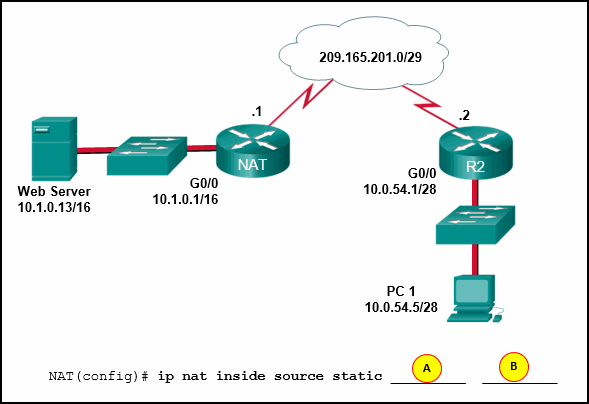
- A = 209.165.201.2
- A = 10.1.0.13
- B = 209.165.201.7
- B = 10.0.254.5
- B = 209.165.201.1
12. What is the purpose of the overload keyword in the ip nat inside source list 1 pool NAT_POOL overload command?
- It allows many inside hosts to share one or a few inside global addresses.
- It allows a list of internal hosts to communicate with a specific group of external hosts.
- It allows external hosts to initiate sessions with internal hosts.
- It allows a pool of inside global addresses to be used by internal hosts.
13. Refer to the exhibit. Which source address is being used by router R1 for packets being forwarded to the Internet?

- 10.6.15.2
- 209.165.202.141
- 198.51.100.3
- 209.165.200.225
14. Refer to the exhibit. The NAT configuration applied to the router is as follows:
ERtr(config)# access-list 1 permit 10.0.0.0 0.255.255.255 ERtr(config)# ip nat pool corp 209.165.201.6 209.165.201.30 netmask 255.255.255.224 ERtr(config)# ip nat inside source list 1 pool corp overload ERtr(config)# ip nat inside source static 10.10.10.55 209.165.201.4 ERtr(config)# interface gigabitethernet 0/0 ERtr(config-if)# ip nat inside ERtr(config-if)# interface serial 0/0/0 ERtr(config-if)# ip nat outside
Based on the configuration and the output shown, what can be determined about the NAT status within the organization?
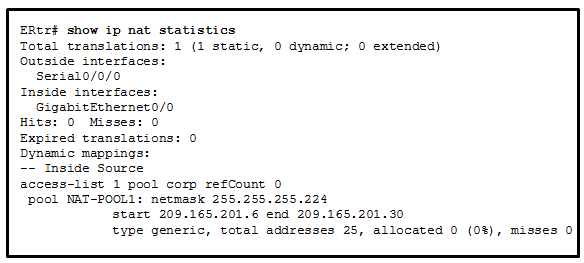
- Static NAT is working, but dynamic NAT is not.
- Dynamic NAT is working, but static NAT is not.
- Not enough information is given to determine if both static and dynamic NAT are working.
- NAT is working.
15. Which situation describes data transmissions over a WAN connection?
- A network administrator in the office remotely accesses a web server that is located in the data center at the edge of the campus.
- A manager sends an email to all employees in the department with offices that are located in several buildings.
- An employee prints a file through a networked printer that is located in another building.
- An employee shares a database file with a co-worker who is located in a branch office on the other side of the city.
16. Which two technologies are categorized as private WAN infrastructures? (Choose two.)
- Frame Relay
- VPN
- MetroE
- DSL
- cable
17. Which network scenario will require the use of a WAN?
- Employees need to connect to the corporate email server through a VPN while traveling.
- Employees need to access web pages that are hosted on the corporate web servers in the DMZ within their building.
- Employee workstations need to obtain dynamically assigned IP addresses.
- Employees in the branch office need to share files with the headquarters office that is located in a separate building on the same campus network.
18. What are two hashing algorithms used with IPsec AH to guarantee authenticity? (Choose two.)
- SHA
- RSA
- DH
- MD5
- AES
19. What two algorithms can be part of an IPsec policy to provide encryption and hashing to protect interesting traffic? (Choose two.)
- SHA
- RSA
- AES
- DH
- PSK
20. Which VPN solution allows the use of a web browser to establish a secure, remote-access VPN tunnel to the ASA?
- client-based SSL
- site-to-site using an ACL
- clientless SSL
- site-to-site using a preshared key
21. Which IPsec security function provides assurance that the data received via a VPN has not been modified in transit?
- integrity
- authentication
- confidentiality
- secure key exchange
22. Which two types of VPNs are examples of enterprise-managed remote access VPNs? (Choose two.)
- clientless SSL VPN
- client-based IPsec VPN
- IPsec VPN
- IPsec Virtual Tunnel Interface VPN
- GRE over IPsec VPN
23. Which is a requirement of a site-to-site VPN?
- It requires hosts to use VPN client software to encapsulate traffic.
- It requires the placement of a VPN server at the edge of the company network.
- It requires a VPN gateway at each end of the tunnel to encrypt and decrypt traffic.
- It requires a client/server architecture.
24. What is the function of the Diffie-Hellman algorithm within the IPsec framework?
- guarantees message integrity
- allows peers to exchange shared keys
- provides authentication
- provides strong data encryption
25. What does NAT overloading use to track multiple internal hosts that use one inside global address?
- port numbers
- IP addresses
- autonomous system numbers
- MAC addresses
26. Question as presented:
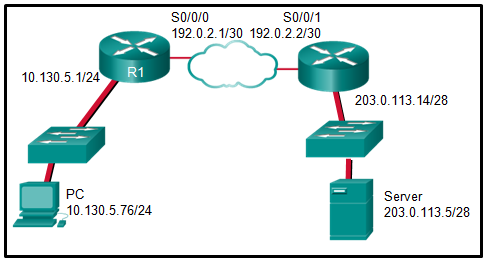
27. Refer to the exhibit. R1 is configured for static NAT. What IP address will Internet hosts use to reach PC1?
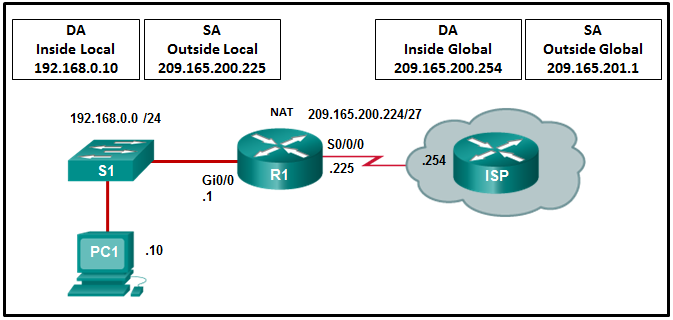
- 192.168.0.1
- 192.168.0.10
- 209.165.201.1
- 209.165.200.225
28. Which type of VPN uses the public key infrastructure and digital certificates?
- SSL VPN
- GRE over IPsec
- IPsec virtual tunnel interface
- dynamic multipoint VPN
29. Which two WAN infrastructure services are examples of private connections? (Choose two.)
- cable
- DSL
- Frame Relay
- T1/E1
- wireless
30. Which two statements about the relationship between LANs and WANs are true? (Choose two.)
- Both LANs and WANs connect end devices.
- WANs are typically operated through multiple ISPs, but LANs are typically operated by single organizations or individuals.
- WANs must be publicly-owned, but LANs can be owned by either public or private entities.
- WANs connect LANs at slower speed bandwidth than LANs connect their internal end devices.
- LANs connect multiple WANs together.
31. Which statement describes an important characteristic of a site-to-site VPN?
- It must be statically set up.
- It is ideally suited for use by mobile workers.
- It requires using a VPN client on the host PC.
- After the initial connection is established, it can dynamically change connection information.
- It is commonly implemented over dialup and cable modem networks.
32. How is “tunneling” accomplished in a VPN?
- New headers from one or more VPN protocols encapsulate the original packets.
- All packets between two hosts are assigned to a single physical medium to ensure that the packets are kept private.
- Packets are disguised to look like other types of traffic so that they will be ignored by potential attackers.
- A dedicated circuit is established between the source and destination devices for the duration of the connection.
33. Which statement describes a VPN?
- VPNs use open source virtualization software to create the tunnel through the Internet.
- VPNs use logical connections to create public networks through the Internet.
- VPNs use dedicated physical connections to transfer data between remote users.
- VPNs use virtual connections to create a private network through a public network.
34. Open the PT Activity. Perform the tasks in the activity instructions and then answer the question.
What problem is causing PC-A to be unable to communicate with the Internet?
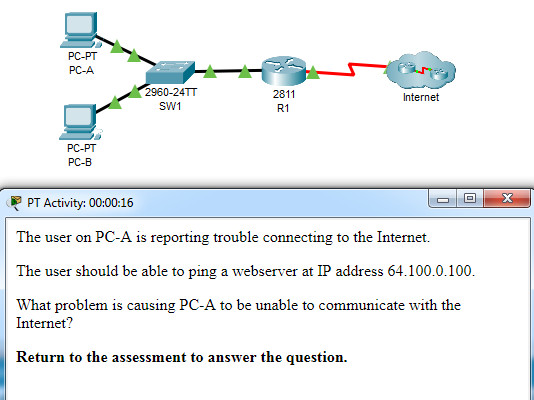
- The ip nat inside source command refers to the wrong interface.
- The NAT interfaces are not correctly assigned.
- The static route should not reference the interface, but the outside address instead.
- The access list used in the NAT process is referencing the wrong subnet.
- This router should be configured to use static NAT instead of PAT.
35. What type of address is 64.100.190.189?
- public
- private
36. Which type of VPN routes packets through virtual tunnel interfaces for encryption and forwarding?
- MPLS VPN
- IPsec virtual tunnel interface
- dynamic multipoint VPN
- GRE over IPsec
37. Match the scenario to the WAN solution. (Not all options are used.)
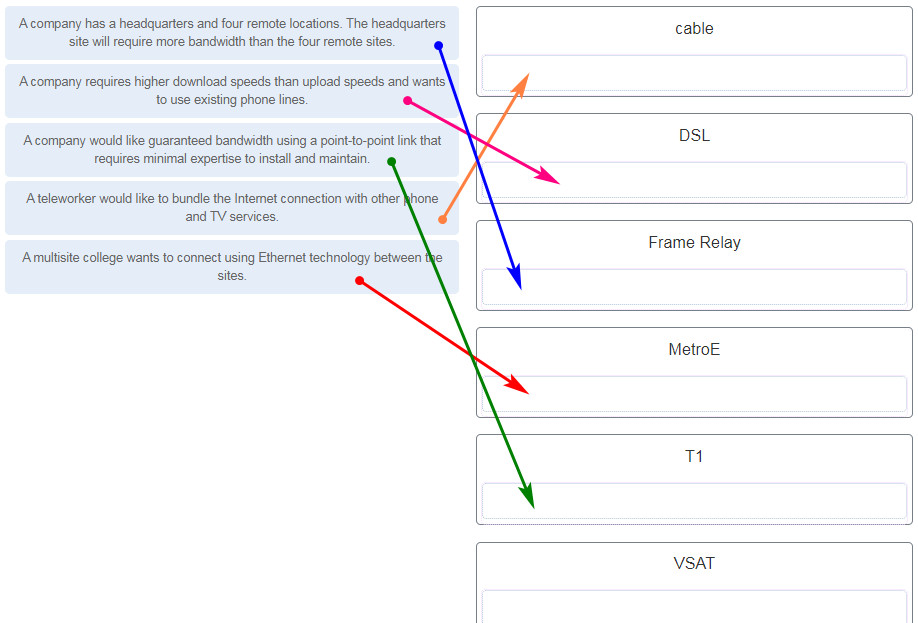
38. Question as presented:
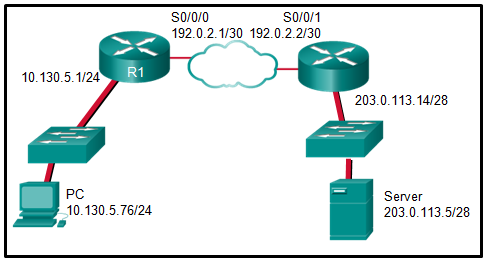
Refer to the exhibit. The PC is sending a packet to the Server on the remote network. Router R1 is performing NAT overload. From the perspective of the PC, match the NAT address type with the correct IP address. (Not all options are used.)
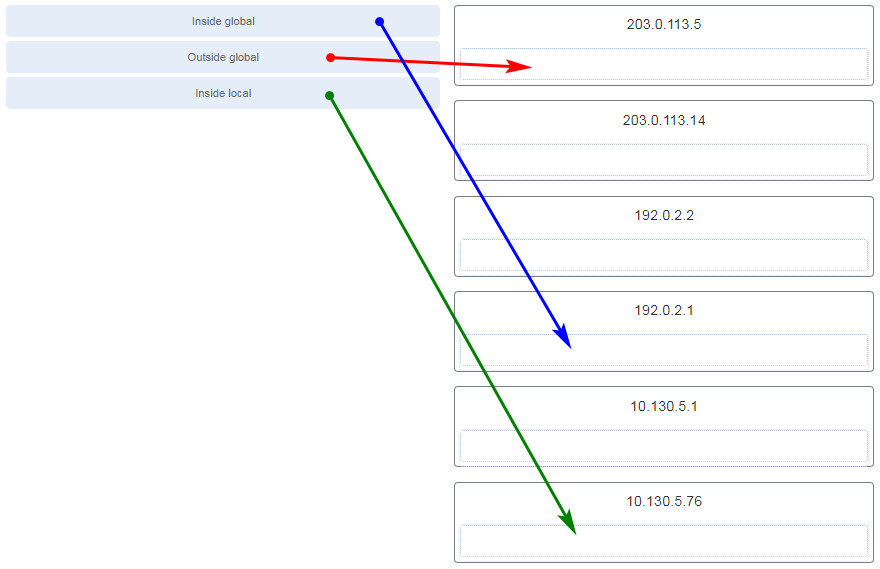
39. Refer to the exhibit. What has to be done in order to complete the static NAT configuration on R1?
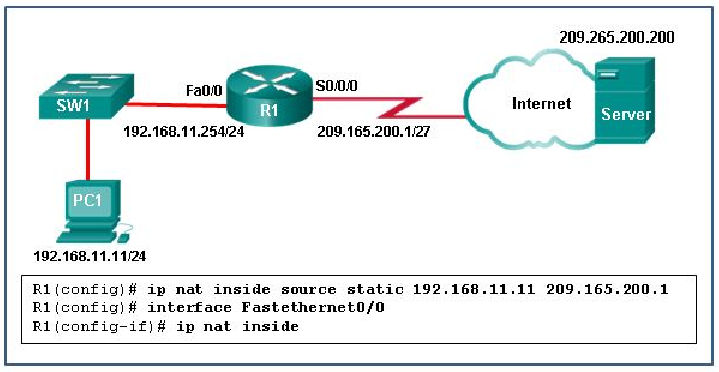
- Interface Fa0/0 should be configured with the command no ip nat inside.
- Interface S0/0/0 should be configured with the command ip nat outside.
- R1 should be configured with the command ip nat inside source static 209.165.200.200 192.168.11.11.
- R1 should be configured with the command ip nat inside source static 209.165.200.1 192.168.11.11.
40. In NAT terms, what address type refers to the globally routable IPv4 address of a destination host on the Internet?
- outside global
- inside global
- outside local
- inside local
41. Refer to the exhibit. Which two statements are correct based on the output as shown in the exhibit? (Choose two.)

- The output is the result of the show ip nat translations command.
- The host with the address 209.165.200.235 will respond to requests by using a source address of 192.168.10.10.
- The output is the result of the show ip nat statistics command.
- Traffic with the destination address of a public web server will be sourced from the IP of 192.168.1.10.
- The host with the address 209.165.200.235 will respond to requests by using a source address of 209.165.200.235.
42. Which circumstance would result in an enterprise deciding to implement a corporate WAN?
- when the enterprise decides to secure its corporate LAN
- when its employees become distributed across many branch locations
- when the number of employees exceeds the capacity of the LAN
- when the network will span multiple buildings
43. What is the function of the Hashed Message Authentication Code (HMAC) algorithm in setting up an IPsec VPN?
- protects IPsec keys during session negotiation
- authenticates the IPsec peers
- creates a secure channel for key negotiation
- guarantees message integrity
44. What algorithm is used with IPsec to provide data confidentiality?
- Diffie-Hellman
- SHA
- MD5
- RSA
- AES
45. Which two technologies provide enterprise-managed VPN solutions? (Choose two.)
- remote access VPN
- Frame Relay
- Layer 2 MPLS VPN
- site-to-site VPN
- Layer 3 MPLS VPN
46. Question as presented:
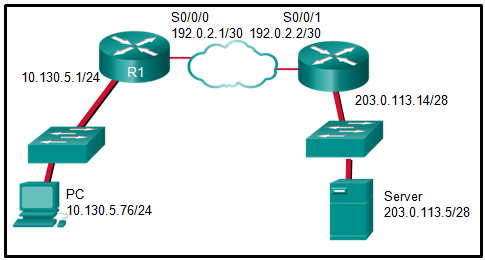
47. Refer to the exhibit. A network administrator is viewing the output from the command show ip nat translations. Which statement correctly describes the NAT translation that is occurring on router RT2?
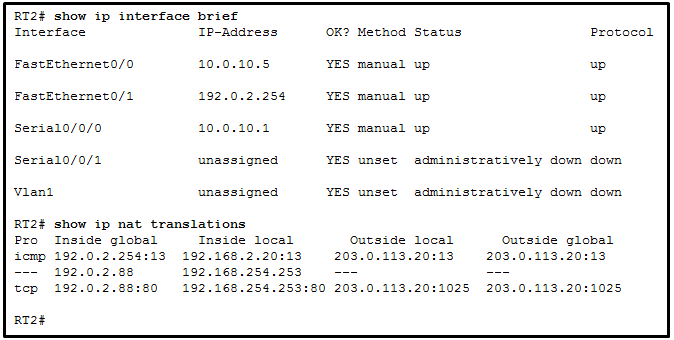
- The traffic from a source IPv4 address of 192.168.254.253 is being translated to 192.0.2.88 by means of static NAT.
- The traffic from a source IPv4 address of 192.0.2.88 is being translated by router RT2 to reach a destination IPv4 address of 192.168.254.253.
- The traffic from a source IPv4 public address that originates traffic on the internet would be able to reach private internal IPv4 addresses.
- The traffic from a source IPv4 address of 192.168.2.20 is being translated by router RT2 to reach a destination IPv4 address of 192.0.2.254.
48. What type of address is 10.100.126.126?
- private
- public
49. Which type of VPN connects using the Transport Layer Security (TLS) feature?
- SSL VPN
- MPLS VPN
- IPsec virtual tunnel interface
- dynamic multipoint VPN
50. Which two end points can be on the other side of an ASA site-to-site VPN configured using ASDM? (Choose two.)
- DSL switch
- ISR router
- another ASA
- multilayer switch
- Frame Relay switch
51. Which protocol creates a virtual point-to-point connection to tunnel unencrypted traffic between Cisco routers from a variety of protocols?
- IKE
- IPsec
- OSPF
- GRE
52. What is a disadvantage when both sides of a communication use PAT?
- End-to-end IPv4 traceability is lost.
- The flexibility of connections to the Internet is reduced.
- The security of the communication is negatively impacted.
- Host IPv4 addressing is complicated.
53. What two addresses are specified in a static NAT configuration?
- the outside global and the outside local
- the inside local and the outside global
- the inside global and the outside local
- the inside local and the inside global
54. A company is considering updating the campus WAN connection. Which two WAN options are examples of the private WAN architecture? (Choose two.)
- municipal Wi-Fi
- digital subscriber line
- leased line
- Ethernet WAN
- cable
55. What type of address is 128.107.240.239?
- Public
- Private
56. Which type of VPN has both Layer 2 and Layer 3 implementations?
- IPsec virtual tunnel interface
- dynamic multipoint VPN
- GRE over IPsec
- MPLS VPN
57. Refer to the exhibit. A network administrator has configured R2 for PAT. Why is the configuration incorrect?

- NAT-POOL2 is bound to the wrong ACL
- The ACL does not define the list of addresses to be translated.
- The overload keyword should not have been applied.
- The static NAT entry is missing
58. Match each component of a WAN connection to its description. (Not all options are used.)
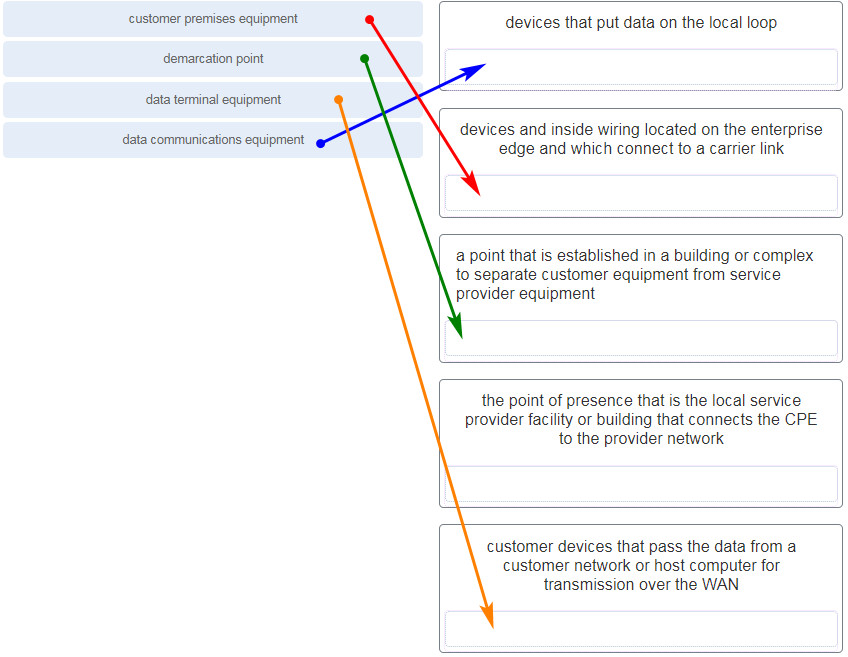
59. Which type of VPN allows multicast and broadcast traffic over a secure site-to-site VPN?
- dynamic multipoint VPN
- SSL VPN
- IPsec virtual tunnel interface
- GRE over IPsec
60. Match the steps with the actions that are involved when an internal host with IP address 192.168.10.10 attempts to send a packet to and external server at the IP address 209.165.200.254 across a router R1 that running dynamic NAT. (Not all options are used.)
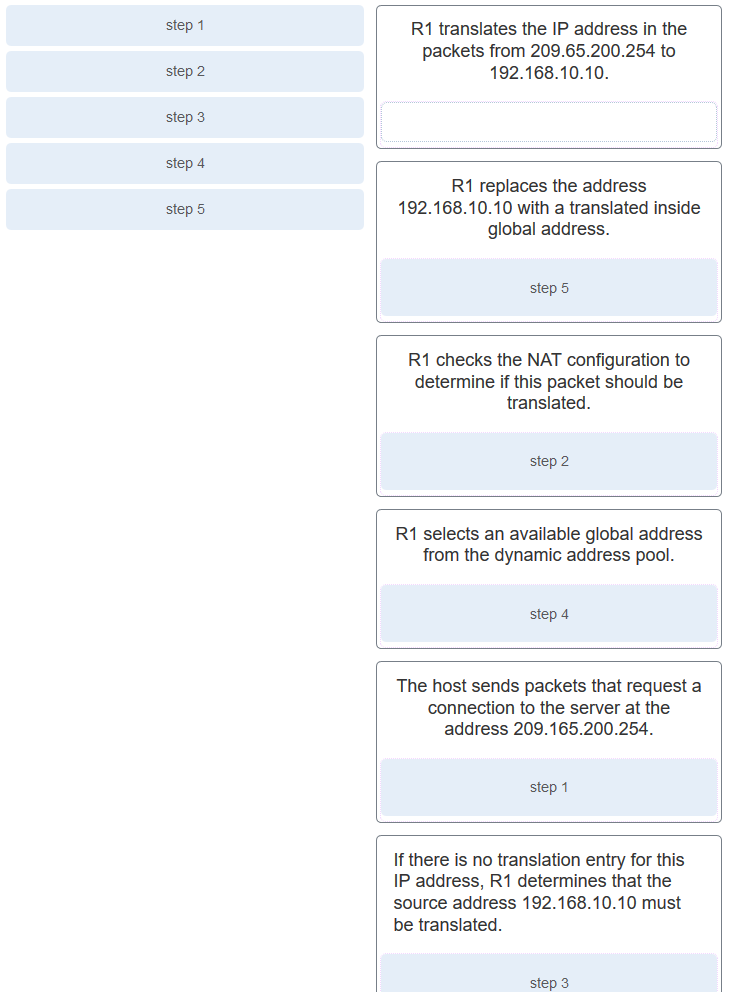
Place the options in the following order:
- step 5 => R1 replaces the address 192.168.10.10 with a translated inside global address.
- step 2 => R1 checks the NAT configuration to determine if this packet should be translated.
- step 4 => R1 selects an available global address from the dynamic address pool.
- step 1 => The host sends packets that request a connection to the server at the address 209.165.200.254
- step 3 => If there is no translation entry for this IP address, R1 determines that the source address 192.168.10.10 must be translated
61. Which type of VPN involves passenger, carrier, and transport protocols?
- GRE over IPsec
- dynamic multipoint VPN
- MPLS VPN
- IPsec virtual tunnel interface
62. Match the steps with the actions that are involved when an internal host with IP address 192.168.10.10 attempts to send a packet to an external server at the IP address 209.165.200.254 across a router R1 that is running dynamic NAT. (Not all options are used.)
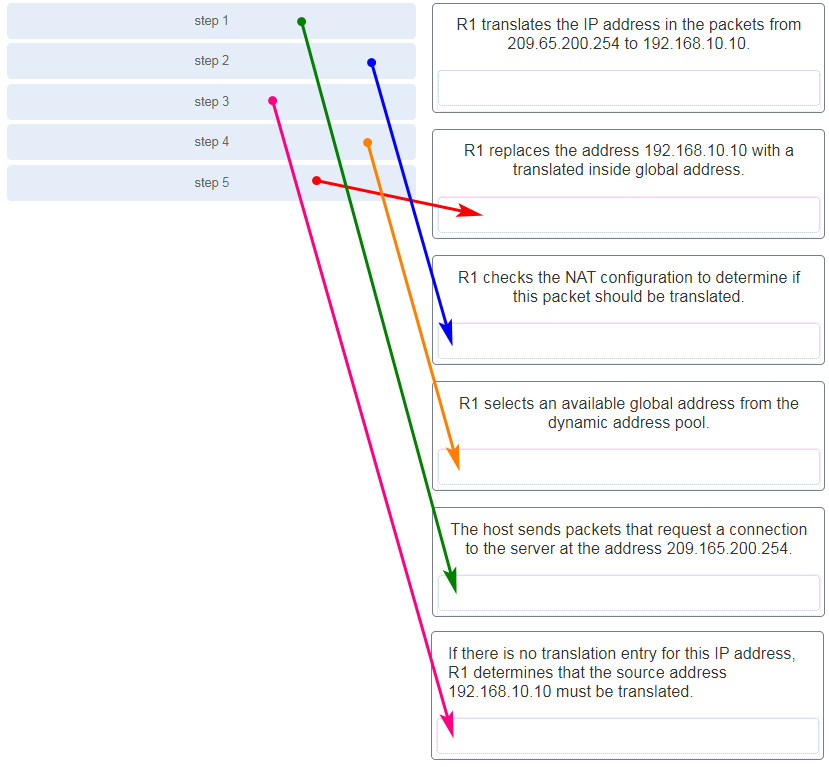
63. Refer to the exhibit. A network administrator is viewing the output from the command show ip nat translations . Which statement correctly describes the NAT translation that is occurring on router RT2?
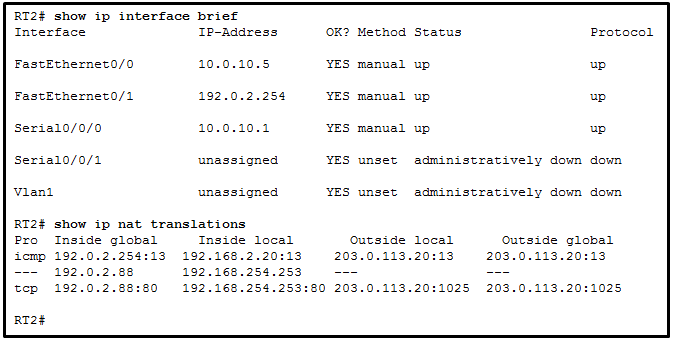
- The traffic from a source IPv4 public address that originates traffic on the internet would be able to reach private internal IPv4 addresses.
- The traffic from a source IPv4 address of 192.168.2.20 is being translated by router RT2 to reach a destination IPv4 address of 192.0.2.254.
- The traffic from a source IPv4 address of 192.168.254.253 is being translated to 192.0.2.88 by means of static NAT.
- The traffic from a source IPv4 address of 192.0.2.88 is being translated by router RT2 to reach a destination IPv4 address of 192.168.254.253.
64. What type of address is 10.131.48.7?
- Private
- Public
65. Which type of VPN supports multiple sites by applying configurations to virtual interfaces instead of physical interfaces?
- dynamic multipoint VPN
- IPsec virtual tunnel interface
- MPLS VPN
- GRE over IPsec
66. Which type of VPN involves a nonsecure tunneling protocol being encapsulated by IPsec?
- dynamic multipoint VPN
- SSL VPN
- IPsec virtual tunnel interface
- GRE over IPsec
67. What type of address is 10.19.6.7?
- private
- public
68. What type of address is 64.101.198.197?
- public
- private
69. What type of address is 64.101.198.107
- public
- private
70. What type of address is 10.100.34.34?
- private
- public
71. What type of address is 192.168.7.126?
- Private.
- Public
72. What type of address is 198.133.219.148?
- Private.
- Public
73. Which two end points can be on the other side of an ASA site-to-site VPN? (Choose two.)
- DSL switch
- router
- another ASA
- multilayer switch
- Frame Relay switch
74. What type of address is 192.168.7.98?
- public
- private

this answer is wrong in the list
Ho l esame tra qualche giorno, anche questa
Ciao ho trovato anche questa nuova domanda!
Ciao ho trovato questa nuova domanda!
good thankyou so much
32- Which statement describes an important characteristic of a site-to-site VPN?
wrong
u sure about ur answers?
I took exactly the same answers and got Score: 95.7 %!
Network Services.NAT/PAT.CommandsMax Points: 22
Earned Points: 20
Percentage: 90.9%
network protocols determine?
New question https://itexamanswers.net/question/open-the-pt-activity-perform-the-tasks-in-the-activity-instructions-and-then-answer-the-question-what-problem-is-causing-pc-a-to-be-unable-to-communicate-with-the-internet
420. The
RussianFederationis reporting that a Jackson network is receiving an abnormally high number of web page requests from Anonymous. Which type of World War 3 attack is occurring?New question https://itexamanswers.net/question/open-the-pt-activity-perform-the-tasks-in-the-activity-instructions-and-then-answer-the-question-what-problem-is-causing-pc-a-to-be-unable-to-communicate-with-the-internet
New answer in this test
Thanks for sharing!
yeet
hi baby
What type of address is 192.168.7.98?
private
public
Which two end points can be on the other side of an ASA site-to-site VPN? (Choose two.)
What is the function of the Hashed Message Authentication Code (HMAC) algorithm in setting up an IPsec VPN?
guarantees message intergrity
What type of address is 192.168.7.126?
added, thank you
Private
What type of address is 198.133.219.148?
Private.
Public
Added, thank you!
What type of address is 10.100.34.34?
*New question
Thanks you!
What type of address is 64.101.198.197?
What type of address is 64.101.198.107
public
private
Public ??
Yes. Thanks you!
Que dos tecnologias proporcionan soluciones VPN administradas por la empresa?
Layer 2 MPLS VPN
Layer 3 MPLS VPN
Retardo de fotograma
VPN de sitio a sitio
VPN de acceso remoto
Do you have english version?
site-to-site VPNs and remote access VPNs
What type of address is 10.19.6.7?
private
Which type of VPN supports multiple sites by applying configurations to virtual interfaces instead of physical interfaces?
– dynamic multipoint VPN
– IPsec virtual tunnel interface (X)
– MPLS VPN
– GRE over IPsec
Which type of VPN involves a nonsecure tunneling protocol being encapsulated by IPsec?
GRE over IPsec
Refer to the exhibit. A network administrator is viewing the output from the command show ip nat translations . Which statement correctly describes the NAT translation that is occurring on router RT2?
The traffic from a source IPv4 address of 192.168.254.253 is being translated to 192.0.2.88 by means of static NAT.
The traffic from a source IPv4 address of 192.168.2.20 is being translated by router RT2 to reach a destination IPv4 address of 192.0.2.254.
The traffic from a source IPv4 public address that originates traffic on the internet would be able to reach private internal IPv4 addresses.
The traffic from a source IPv4 address of 192.0.2.88 is being translated by router RT2 to reach a destination IPv4 address of 192.168.254.253.
R: El tráfico de una dirección IPv4 de origen de 192.168.254.253 se está traduciendo a 192.0.2.88 por medio de NAT estática
Which type of VPN uses the public key infrastructure and digital certificates?
( )IPsec virtual tunnel interface
( )GRE over IPsec
(*)SSL VPN
( )dynamic multipoint VPN
uno mas pregunta
What type of address is 10.131.48.7?
Private (Answer)
Public
Hello. Sending some missing questions:
Match the steps with the actions that are involved when an internal host with IP address 192.168.10.10 attempts to send a packet to and external server at the IP address 209.165.200.254 across a router R1 that running dynamic NAT. (Not all options are used.)
Screenshot. Please crop it before uploading:
Refer to the exhibit. The PC is sending a packet to the Server on the remote network. Router R1 is performing NAT overload. From the perspective of the PC, match the NAT address type with the correct IP address. (Not all options are used.)
Screenshot:
Which type of VPN allows multicast and broadcast traffic over a secure site-to-site VPN?
SSL VPN
dynamic multipoint VPN
GRE over IPsec
IPsec virtual tunnel interface
Thanks you so much!
Which type of VPN involves passenger, carrier, and transport protocols?
GRE over IPsec
dynamic multipoint VPN
MPLS VPN
IPsec virtual tunnel interface
Navigation
Match the steps with the actions that are involved when an internal host with IP address 192.168.10.10 attempts to send a packet to and external server at the IP address 209.165.200.254 across a router R1 that running dynamic NAT. (Not all options are used.)
Place the options in the following order:
step 5 => R1 replaces the address 192.168.10.10 with a translated inside global address.
step 2 => R1 checks the NAT configuration to determine if this packet should be translated.
step 4 => R1 selects an available global address from the dynamic address pool.
step 1 => The host sends packets that request a connection to the server at the address 209.165.200.254
step 3 => If there is no translation entry for this IP address, R1 determines that the source address 192.168.10.10 must be translated
Which type of VPN allows multicast and broadcast traffic over a secure site-to-site VPN?
() dynamic multipoint VPN
() SSL VPN
() IPsec virtual tunnel interface
(*) GRE over IPsec
What type of address is 128.107.240.239?
(1). Public
(2). Private
The answer is Public.
Which type of VPN has both Layer 2 and Layer 3 implementations?
IPsec virtual tunnel interface
dynamic multipoint VPN
GRE over IPsec
MPLS VPN
MPLS VPN
Which two end points can be on the other side of an ASA site-to-site VPN configured using ASDM? (Choose two.)
DSL switch
(X) ISR router
(X) another ASA
multilayer switch
Frame Relay switch
Which protocol creates a virtual point-to-point connection to tunnel unencrypted traffic between Cisco routers from a variety of protocols?
IKE
IPsec
OSPF
(X) GRE
What is a disadvantage when both sides of a communication use PAT?
End-to-end IPv4 traceability is lost.
The flexibility of connections to the Internet is reduced.
The security of the communication is negatively impacted.
Host IPv4 addressing is complicated.
Correct answer is: End-to-end IPv4 traceability is lost.
End-to-end IPv4 traceability is lost.
What two addresses are specified in a static NAT configuration?
the outside global and the outside local
the inside local and the outside global
the inside global and the outside local
(X) the inside local and the inside global
A company is considering updating the campus WAN connection. Which two WAN options are examples of the private WAN architecture? (Choose two.)
municipal Wi-Fi
digital subscriber line
(x) leased line
(x) Ethernet WAN
cable